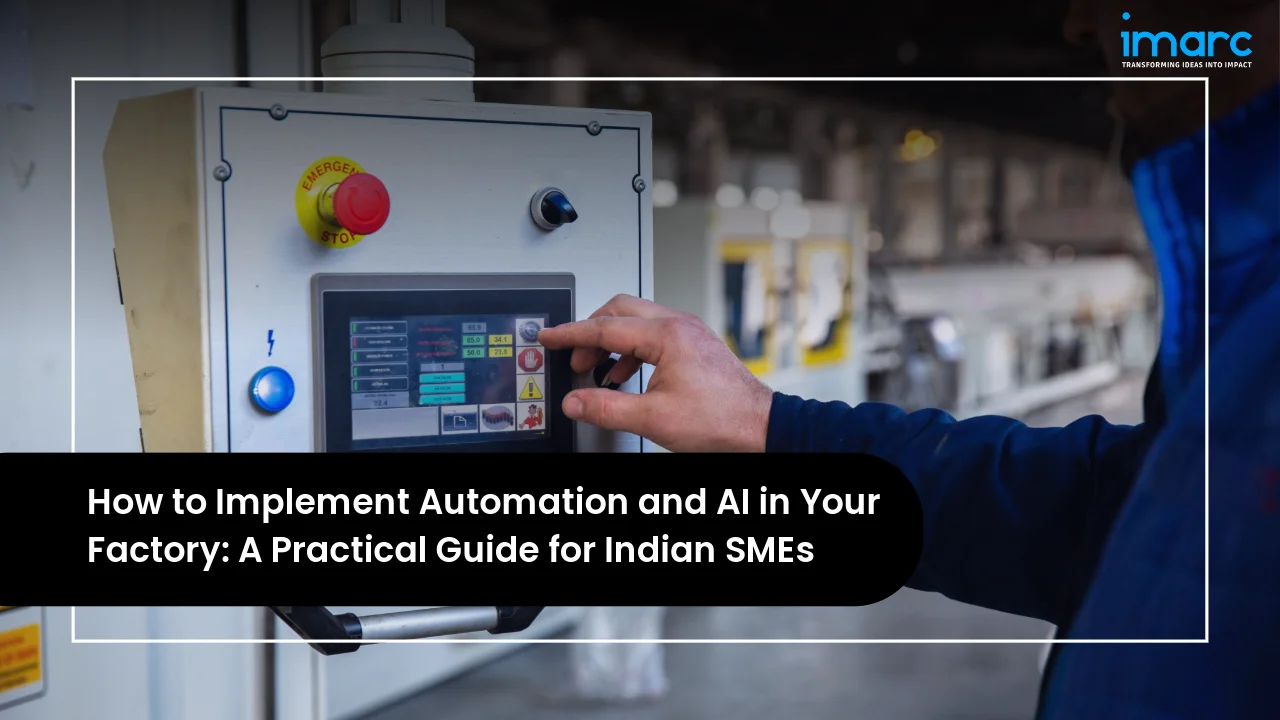How to Implement Automation and AI in Your Factory: A Practical Guide for Indian SMEs

Indian manufacturers are facing difficulties due to rising input costs, shortages of skilled labour, unplanned machine downtime, and inconsistent product quality. According to an industry report, during the July–September quarter of FY25, raw material expenses for 1,679 listed non-financial manufacturing companies increased by 5.1%, outpacing sales growth, which rose by only 3.3%. Similarly, the Global Talent Shortage Survey 2025 reported that 80% of Indian employers report difficulty finding skilled talent, compared to the global average of 74%, highlighting a severe talent crunch. These persistent challenges limit efficiency and profitability, particularly for small and medium-sized enterprises.
Artificial intelligence is no longer a distant or exclusive technology. SMEs are already adopting it to reduce waste, anticipate equipment failures, and enhance production reliability. An industry report shows that 45% of SMEs are already using AI, and 80% of those report improvements in efficiency and profitability. Moreover, entering this space does not demand large-scale investments or highly specialized technical teams. Businesses can begin their AI journey with targeted, practical applications that deliver measurable improvements and build a foundation for broader adoption.
Below is a practical guide for Indian SMEs on getting started with AI in manufacturing, structured around current industry challenges, opportunities, and actionable steps. It outlines a step-by-step path, beginning with identifying pain points and moving toward scaling successful pilots. The blog also highlights practical ways to navigate obstacles and build a sustainable approach to AI adoption.
1. Why AI Matters for SMEs in Manufacturing?
AI is increasingly becoming a game-changer for 6.2 crore registered small and medium-sized manufacturers in India. With mounting pressure to stay competitive, reduce costs, and improve productivity, SMEs can no longer ignore the potential of AI. According to the International Journal of Management and Social Science, the major challenge faced by SMEs is excessive competition in the market, with 89.29% of SMEs identifying it as a critical issue. The technology offers solutions to some of the most persistent challenges, from unpredictable machine breakdowns to fluctuating raw material costs. By adopting AI, even on a small scale, Indian manufacturers can significantly enhance efficiency.
Key Advantages AI brings to manufacturing operations:
- Predictive Maintenance: AI predicts equipment failures by analyzing data, allowing for timely maintenance and reducing unplanned downtime.
- Cost Reduction: AI optimizes energy use and resource allocation, cutting material waste and lowering operational costs.
- Quality Control: AI-powered vision systems detect defects early, ensuring consistent product quality and minimizing scrap.
- Improved Production Planning: AI optimizes scheduling and inventory management, increasing efficiency and minimizing delays.
- Competitive Advantage: AI integration enhances agility and decision-making, helping SMEs stay competitive and responsive to market needs.
2. Step-by-Step Guide to Implementing AI in SME Manufacturing:
Implementing AI in a manufacturing SME can seem daunting, but with a structured approach, it becomes manageable and highly rewarding. Below is a clear, step-by-step guide, focusing on practical actions that can lead to improvements in efficiency and productivity.
- Identifying a Pain Point
The first step is to identify a specific pain point or operational inefficiency that needs attention. This could range from frequent machine breakdowns and high energy consumption to slow production rates or poor product quality. Similarly, focusing on one area where AI can offer measurable improvements ensures a targeted approach, making the process less overwhelming for SMEs. Moreover, a successful initial implementation also helps build confidence and momentum for broader AI adoption. For example, a 2022 Enterprise Survey Study by the World Bank highlighted tax rates and compliance as one of the top three business environment constraints for small, medium, and large enterprises, with its prominence increasing from 2014 to 2022. Interestingly, an industry survey found that 94% of Indian CFOs and tax leaders believe Generative AI can revolutionize tax functions. So, by prioritizing critical pain points, SMEs can ensure that AI solutions directly impact their business, securing buy-in from stakeholders and establishing a strong foundation for further AI integration.
- Collecting the Right Data
Data collection is a critical step for the successful implementation of AI, as it provides the necessary input for AI models to generate valuable insights and predictions. In line with this, collecting relevant data, such as machine logs, sensor readings, and shop floor records, ensures that AI algorithms enable accurate and actionable recommendations. The quality and granularity of the data directly influence the performance of the AI solution. An industry survey revealed that organizations confident in their data are three times more likely to exceed their AI ROI expectations. Therefore, it is essential to gather data that is directly relevant to the identified pain points, as this data will drive informed decision-making.
- Start Small and Pick Simple AI Tools
Starting with a small-scale pilot on a single production line or process minimizes risk and allows businesses to test AI in a controlled environment. This limited scope enables manufacturers to refine their approach before scaling. By selecting simple, ready-to-use AI tools from established vendors, SMEs avoid the complexities and costs of developing custom solutions. These plug-and-play tools, designed for specific challenges like predictive maintenance or quality control, integrate easily with existing systems and are quick to deploy. Running a small pilot with these tools ensures a more manageable implementation, helping businesses understand the system's impact and streamline broader adoption.
- Training the Team
For AI adoption to succeed, the team responsible for managing and operating the technology must possess the required skills. According to an industry report, nearly 50% of tech workers in India are receiving AI upskilling support, positioning the country to lead in the global AI race. Furthermore, training should focus on basic digital skills, such as understanding AI tools, interpreting results, and making data-driven decisions. A recent study shows that 76% of Indians trust AI, and 90% believe it enhances accessibility and effectiveness. Hence, proper training helps employees interact with AI systems, analyze outputs, and integrate AI smoothly into operations. Also, well-trained staff ensures AI solutions are utilized effectively, maximizing their potential and leading to more successful implementation.
- Measuring Results and Scale
After implementing the AI solution on a small scale, it is important to track performance and measure ROI by monitoring key performance indicators (KPIs) like downtime reduction, quality improvements, and cost savings. In tandem, analyzing these results helps determine if the AI application is addressing the problem and delivering value. If successful, the solution is expanded to other processes or production lines incrementally, ensuring it continues to meet developing business needs. Besides this, regular performance assessments and data-driven scaling ensure that AI provides long-term benefits and supports ongoing business improvements.
3. Challenges in AI Adoption:
- High Initial Costs: The upfront costs of AI technology, including software, hardware, and training, present a significant challenge for SMEs with limited financial resources. A recent Niti Aayog report reveals that 59% of India's MSMEs face financial barriers to investing in AI, with 91% of MSMEs advocating for AI to be made affordable and democratically accessible.
- Lack of Skilled Workforce: A study by the Institute for Competitiveness for Niti Aayog found that 72% of MSMEs face challenges in accessing training to upskill their workforce for AI implementation. This lack of training and technical expertise in AI, data science, and machine learning limits their ability to effectively adopt AI systems.
- Data Quality and Availability: AI systems rely on large amounts of accurate, structured data, but many SMEs lack the infrastructure or resources to collect, manage, and analyze this data efficiently.
In essence, AI presents a valuable opportunity for Indian SMEs to enhance competitiveness and resilience. By adopting AI early, SMEs can improve operations, reduce costs, and increase productivity. Taking small, manageable steps towards AI adoption positions these businesses for long-term success in an increasingly digital industry. Therefore, the earlier SMEs embrace AI, the better prepared they are to navigate future challenges and capitalize on emerging opportunities present in the market.
Our Clients
Contact Us
Have a question or need assistance?
Please complete the form with your inquiry or reach out to us at
Phone Number
+91-120-433-0800+1-201-971-6302
+44-753-714-6104
.webp)










